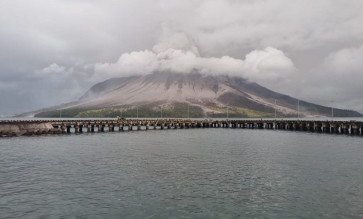Capturing Gorontalo's rich biodiversity on camera
Hunting is Idham Aliâs passion
Change Size

H
unting is Idham Ali's passion. In his spare time he prepares his gear and wakes up very early before heading off in his car to a forest or other hunting ground.
But instead of carrying a gun and bullets, the father of two uses a Canon 5D MII camera with a 100-400-millimeter lens as his 'weapon' of choice.
Since last year, the photography hobbyist has focused on wildlife, especially various bird species.
For his passion, he is willing to walk kilometers deep into forests or stay quiet for hours in a camouflage suit while enduring hunger ' just to be able to snap the animals with his camera.
Maleo. (Courtesy of Idham Ali/MFG)
Almost every Sunday morning, he sets his eyes and lens on birds ' returning home at dusk or even staying the night somewhere.
'It's the risk of my pursuit, apart from annoying my wife!' Idham laughed.
Although still new to wildlife photography, Idham has collected over 1,000 shots of 100 bird species.
He captured Sulawesi's Maleo bird in several places, such as Panua Nature Reserve in Pohuwato regency and Bogani Nani Wartabone National Park in Bone Bolango regency.
'I was able to photograph the Maleo in Panua after four weeks ' or four trips from Gorontalo city to Pohuwato ' since this rare species is very sensitive to the presence of humans,' said Idham, who is also the chairman of the Gorontalo Photography Society (MFG).
He said villagers were the main source of information in terms of finding locations to spot certain birds.
'When they see me holding a camera, most of them are usually willing to show me where the birds can be found. Some even guide me there.'
This has helped him expand his photo collection, which includes dozens of grosbeak starlings ' locally known as jalak tunggir merah, another species endemic to Sulawesi ' in Atinggola, North Gorontalo.
He found the starlings under rotten trees where they were nesting, not far from the regency's main road.
However, not all of his photo-hunting trips are a success. He often returns home empty handed or faces the painful reality of his work.
In a forest in Pohuwato, Gorontalo's westernmost regency, he discovered a spot where dozens of julang Sulawesi or knobbed hornbills were perched elegantly on tall branches, but a number of hunters wielding air rifles were approaching.
They let him take pictures of the hornbills, but then proceeded to shoot the birds.
'I think it was the most distressing, tragic moment I have experienced in this hobby. I rushed home, holding the camera tightly.'
Idham always carries a book published by Birdlife International as a field guide on birds in the Wallacea zone of Sulawesi, Maluku and Nusa Tenggara. It describes 697 sedentary and migratory birds, of which 252 species have endemic status within the zone.

During his trips, he also encounters other animals in remote forest areas and around Gorontalo city, such as groups of Sulawesi monkeys and bear cuscus.
Photographer Rosyid Azhar said Gorontalo city was home to many spots where people could observe different animals.
In the Botu hilly area, which now hosts the governor's office and the provincial legislative council (DPRD I), he said he once found groups of monkeys and even photographed Sulawesi's serak, or masked owls.
One early morning, Rosyid and his colleague even heard duet calls of male and female tarsiers living in trees near Fort Otanaha, a Portuguese heritage building located in Dembe subdistrict, Gorontalo city.
'Normally, we only find tarsiers in national parks, so it was a pleasant surprise to see them in the city area,' he says.









